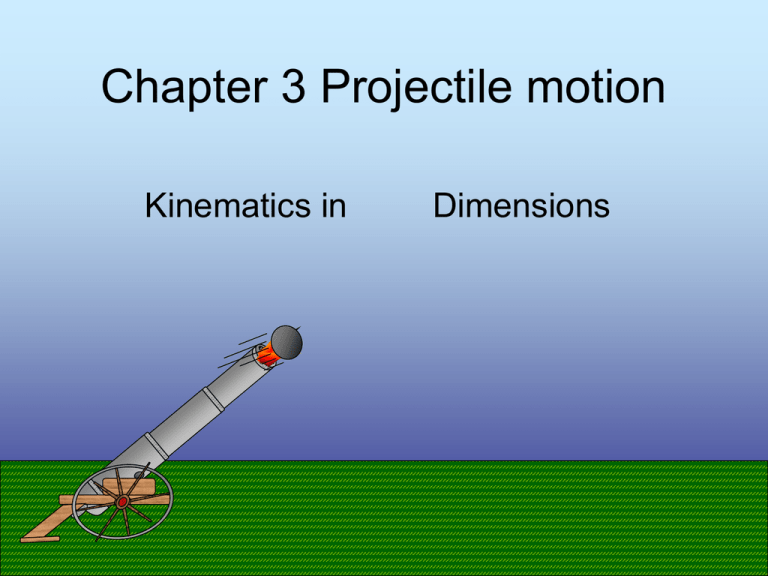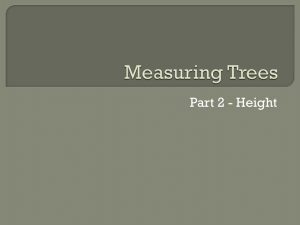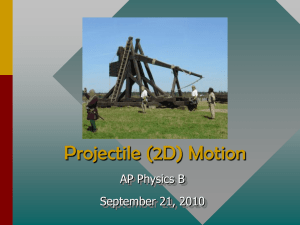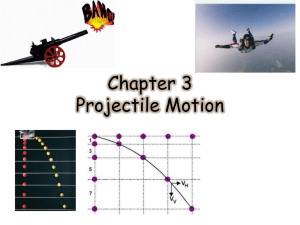Chapter 4 Acceleration
advertisement

Chapter 3 Projectile motion Kinematics in Dimensions Projectile Motion • Projectile motion is motion in two directions • Motion in the x-direction is independent of the y-direction • Motion in the y-direction is independent of the x-direction What is a Projectile? • A projectile is any object that is placed into free flight and is being affected by gravity. g 9.8 m s 2 • The path of a projectile is called the trajectory. The Full Parabola • The key to the full parabola is symmetry. • Try to identify some points of symmetry. Throw Vy Vx Half Parabola Timing • The time of flight of a half parabolic path is equal to that of simply dropping the object from the same height. Horizontal velocity (vx) has no affect on flight time because it is not affected by gravity. Jill drops the yellow ball and throws the red ball horizontally. Which ball will hit the ground first? X & Y are Independent Object launched horizontally Multi media studio What do you notice about the horizontal velocity in each of the following animations? • Horizontally launched projectiles • The plane and the package • The truck and the ball A stone is thrown horizontally from the top of a 78.4m high cliff at 5m/s. Var a v1 v2 d1 a) How long does it take to reach the bottom? X Y Want d2 t v v 2 gd 2 2 2 1 v2 v1 gt 1 2 d v1t gt 2 d (v1 v2 )t A stone is thrown horizontally from the top of a 78.4m high cliff at 5m/s. a) How long does it take to reach the bottom? 1 2 d y = v y t + at 2 2y t g 2(78.4m) t 9.8 m s2 t 4.0s A stone is thrown horizontally from the top of a 78.4m high cliff at 5m/s. b) How far from the base does it land? d x = vx t dx 5 dx m s (4.0s) d x 20m A stone is thrown horizontally from the top of a 78.4m high cliff at 5m/s. c) What are the final vy and vx ? vy 2 v 2 2 y1 2ad vy 2 v 2 y1 vx 2 vx1 2ad vy 2 (0 s ) 2(9.8 m s2 )(78.4m) m 2 vy 2 39.2m / s Sample Partial WS 7a #1 • A cannon nestled in the side of a cliff (d1y = 65m) fires a cannon ball at 26 ms . How long until the ball splashes into the sea? Fire Sample Problem • A toy car is raced off a table (1.1m high) onto the floor below. – How long did it take for the car to crash on the floor? 0 d2 y d1y v1yt 12 gt 2 t t 2 d 2 y d1 y g 2 0m 1.1m 9.8 sm2 t 0.474 s Projectile Motion Type Not all object are launch horizontally Objects can be launched at an angle • Recall the trajectory of the golf ball when hit with a 3 iron. • What would the trajectory of a 9 iron look like? • The loft of the club changed the launch angle. Projectile Motion Path Plot Vertical Position dy (m) 30 25 20 15 10 5 0 0 10 20 30 40 50 Horizontal Position dx (m) • Object 1 was launched at 60o • Object 2 was launched at 30o 60 Projectile Motion Path Plot Vertical Position dy (m) 30 25 20 15 10 5 0 0 10 20 30 40 50 60 Horizontal Position dx (m) • Object 1 was launched from a 25m high cliff at 0o • Object 2 was launched at 60o Initial Velocity Breakdown • When an object is launched at some angle, it’s initial velocity (v1) can be broken down into two components. – Horizontal Component (Vx) – Vertical Component (Vy) • What shape is formed? • Consider also the launch angle (q). v1 horizontal and vertical v1yPlease Note: components are independent of one another. The only commonality is time. q v1x Initial Velocity Breakdown (Cont.) • Consider the breakdown from the previous slide again. • There are trigonometric relationships between the sides and angles of a right triangle. Important! v1 q v1x v1y v1 y opp sin q hyp sin q adj cos q hyp v1x cos q v1 opp tan q adj v1 y tan q v1 v1x Practicing Trig Functions • Consider the triangle below. • Solve for the unknown values. 13 Searching for x Searching for y adj cos q hyp opp sin q hyp y cos 22.62 x 13 22.62° x y sin 22.62 13 x 13 cos 22.62 y 13 sin 22.62 x 12 y5 Sample Velocity Breakdown • A dart gun is fired at an angle of 30° with a muzzle velocity of 40m/s. • Calculate the components of the velocity? v1 q v1x v1x 34.6 ms v1y 20 ms Horizontal Vertical Component (y) (x) v1y vv11yx cosqq sin vv11 v11yx v1 sin cosqq cos30 30 v11yx 40 ms sin m m v11yx 20 34.6 s s • Given an initial velocity of 40m/s and an angle of 25 • find v1x & v1y Searching for y Searching for x O sin q H A cos q H sin q vx cos q v vx 40cos 25 o vx 36.25 vy v vy 40sin 25 o vy 16.9 v1y q =25o v1x Sample Full Parabola Problem • A golf ball is struck at an angle of q = 36° with the horizontal at a velocity of 45m/s. – What are the components of the velocity (v1x and v1y)? Horizontal Component Strike v1x v1 cos q v1x 45 ms cos 36 v1x 36.4 ms v1 q v1x v1y Vertical Component v1 y v1 sin q v1y 45 ms sin 36 v1y 26.4 ms Problem Solving Strategies • Solve for the horizontal component Vxi – • Use trig functions Solve for the vertical component Vyi – Use trig functions • Solve each direction (x & y) separately • Symmetry can be used when the launching & landing places are the same height. A football player kicks a ball at 27m/s at an angle of 30°. Horizontal a) Find the hang time b) find the horizontal distance the ball travels. b) The maximum height of the ball. V V K a g -9.8 V1x v1y v2x v2y dx t K W Vertical dx W dy dy t t Step 1: Solve for the horizontal and vertical components (V1x & V1y ) 30 o Searching for y Searching for x vy v sin q vx v cosq vx 27cos30 o vx 23.4 V1x= ?m/s m s vy 27sin30 vy 13.5 m s V1y= ?m/s Problem Solving Strategies Problem Solving Strategies Step 2: Solve each direction (x & y) separately Symmetry can be used when the launching & landing places are the same height. 15.0m/s 12.5m/s 10.0m/s 7.50m/s 5.00m/s 2.50m/s 0.00m/s A football player kicks a ball at 27m/s at an angle of 30°. a) Find the hang time b) find the horizontal distance the ball travels. b) The maximum height of the ball. Horizontal V K W a Vertical V K g -9.8 v1x 23.4 V1y 13.5 v2x 23.4 v2 y dx t dx W dy dy t t A football player kicks a ball at 27m/s at an angle of 30°. a) Find the hang time v2 v1 v2 v1 gt t v2 y v y1 g (v1 ) v1 gt 13.5 13.5 t 9.8 sm2 t 2.75 s m s m s A football player kicks a ball at 27m/s at an angle of 30°. b) Find the horizontal distance dx vx t d x (23.4 )*(2.75s) m s d x 64.3m A football player kicks a ball at 27m/s at an angle of 30°. c) Find the maximum height What is true about the vertical velocity at the maximum height? 15.0m/s 12.5m/s 10.0m/s 7.50m/s 5.00m/s 2.50m/s 0.00m/s A football player kicks a ball at 27m/s at an angle of 30°. Find the max height v v d 2g 2 2 v v 2gd 2 2 2 1 0 (13.5 ) d 2( 9.8 ) 2 m 2 s m s2 d 9.3m 2 1 • • • An arrow is shot at 44m/s at an angle of 60° Find the maximum height of the arrow. Find the horizontal distance the arrows travels. Find the hang time @ d y (max) vy 0 ms dX @ dy 0 v2 y v1 y Step 1: Solve for the horizontal and vertical components (V1x & V1y ) 60 o Searching for y Searching for x vx cos q v sin q vx 44cos60 o vx 22 m s V1x= ?m/s vy v vy 44sin 60 vy 38.1 m s V1y= ?m/s Problem Solving Strategies An arrow is shot at 44m/s at an angle of 60° a) Find the hang time Horizontal V b) find the horizontal distance the arrows travels. K W a v1x 22 dx t V K g -9.8 W v1y 38.1 v2x c) The maximum height of the arrow. Vertical v2y dx dy dy t t A football player kicks a ball at 44m/s at an angle of 60°. a) Find the hang time vy 2 vy1 vy 2 vy1 gt t v2 y v y1 g (vy1 ) vy1 gt 38.1 38.1 t 9.8 sm2 m s t 7.78 s m s A football player kicks a ball at 44m/s at an angle of 60°. b) Find the horizontal distance dx vx t d x (22m / s)*(7.78s) d x 171.2m A football player kicks a ball at 44m/s at an angle of 60°. Find the max height Recall, vy=0 at dy max v v 2ad 2 y2 2 y1 d 0 (38.1 ) d 2( 9.8 ) 2 m 2 s m s2 d 74.0m v v 2 y2 2a 2 y1 Adding Vectors Graphically • You walk 5m @ 0o and then turns to walk 6m @90o. Finally, you turn to walk 8 m at 200°. What is your displacement? Addition is commutative! dR 4@ 120 Adding Force Vectors Analytically cos q opposite sin q Opposite Hypontenuse q adjacent Hypontenuse adjacent tan q opposite adjacent o tan ( ) q a 1 Components of Vectors Finding the vector magnitude and direction when you know the components. A Ax2 Ay2 tan q Ay Ax q tan 1 Ay Ax Recall: q is measured from the positive x axis. Caution: Beware of the tangent function. Always consider in which quadrant the vector lies when dealing with the tangent function. I II q tan 1 (5/ 8.66) q 30 q 150 q tan 1 (5/ 8.66) q 30 5 5 -8.66 -8.66 8.66 -5 -5 q tan 1 (5/ 8.66) q 30 q 210 III 8.66 q tan 1 (5/ 8.66) q 30 q 330 IV Adding Vectors Analytically Ax A cosq Ay A sin q A 4.5 N @ 30 By B sin q B 7 N @ 210 Bx B cosq Cy C sin q C 6 N @150 Cx C cos q o o o Magnitude Angle 4.5N 7N 6N --------------- 30o 210o 150o ------------ X component Y component 3.89N -6.06N -5.19N Rx=-7.36N 2.25N -3.5N 3.0N Ry=1.7N Adding Vectors Analytically Rmag R R 2 x q tan ( 1 2 y Rmag (7.36) 1.7 2 2 Magnitude Angle 4.5N 7N 6N --------------- 30o 210o 150o ------------ R=7.55N Ry ) Rx 1.7 1 q tan ( ) 7.36 X component Y component 3.89N -6.06N -5.19N Rx=-7.36N 2.25N -3.5N 3.0N Ry=1.7N Angle =-13o+180o = 167o Concept Questions • A stone is thrown horizontally from a cliff. • How would the x distance change if the stone was thrown twice as fast? d x = vx t dx = (2vx ) t • dx distance would double Concept Questions • How would the v2y change if the stone was thrown twice as fast? • Vx and Vy are independent • Since it was thrown horizontally, it would not change. Concept Questions • How would the v2y change if the cliff was twice as high? vy 2 v 2 2 y1 2gd vy 2 2 gd vy 2 2 g (2d ) v2 y 2 2 gd The Partial Parabola • Recall, this path has elevation and launch angle. • The trajectory again has an apex. • This is mathematically the most complex path. Fire Sample Partial Parabola Problem • A cannon nestled in the side of a cliff (d1y = 20m) fires a cannonball at 130m/s at a 40° angle. – What are the components of the initial velocity? Horizontal Component v1x v1 cos q Fire Vertical Component v1 y v1 sin q v1x 130 ms cos 40 v1y 130 ms sin 40 v1x 99.6 ms v1y 83.6 ms v v 2 2 gd t g Sample Partial Parabola Problem • A cannon nestled in the side of a cliff (d1y = 20m) fires a cannonball at 130m/s at a 40° angle. Fire Partial Parabola Variable • You are trying to win a prize by throwing an apple into a basket on top of a pedestal. • The apple leaves your hand 1.00 m beneath the top of the pedestal. • The apple flies 3.09 m horizontally before landing in the bottom of the basket. • The apple’s maximum height was 1.26 m. • What was the apple’s initial velocity (magnitude and direction)? a v1 v2 d1 d2 t x y Partial Parabola • Find V1y knowing Dy max = 1.26m 2 2 2 v vy 2 vy1 2gd y 2 2 gd v y1 vy 2 2gd v 2 2 y1 vy1 (0 ms )2 2(9.8 sm2 )(1.26m) vy1 4.97 ms Dy (max) = 1.26m Partial Parabola Find the hang time knowing v1y and ending height d2y=1m 1 2 d 2 y v1t gt 2 v1 y v1 y 2 4(.5)( g )(d ) 2 b b 4ac t x 2(.5)( g ) 2a 1 a g 2 b v1 y c d t .73s Partial Parabola Partial parabolas can be represented by two half parabolas Total hang time is the time of the ½ parabola on the way up plus the time of the ½ parabola on the way down. t .73s t v2 y v1 y g t .5s t 2d y g t .23s The Partial Parabola • If you look at this path carefully, you can see two half parabolas, which simplifies things considerably. • You still must consider the launch angle and the components of the velocity when trying to solve. q Mortar Problems • A mortar crew fires a projectile at an enemy ammunitions storage facility that is protected by a wall located on top of a 200.0 m high cliff. • The ammunition is located a horizontal distance of 314.68 m from the mortar’s position. • The projectile passes directly over the wall at its maximum height of 215.24 m. • What was the projectile’s initial velocity (magnitude and direction)? V a v1 v2 d1 d2 t x y









